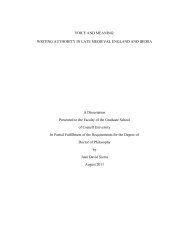Briana Anderson - Cornell University
Briana Anderson - Cornell University
Briana Anderson - Cornell University
Create successful ePaper yourself
Turn your PDF publications into a flip-book with our unique Google optimized e-Paper software.
37<br />
Demographic and Involvement Frequencies<br />
The following tables present the frequencies of the demographic (gender) and<br />
involvement variables.<br />
Table 6<br />
Frequencies for Gender<br />
Frequency Percentage<br />
Male<br />
Female<br />
Table 7<br />
26<br />
110<br />
19.1<br />
80.9<br />
Frequency Table for Dichotomous Personal Involvement Variable<br />
Personal<br />
Involvement<br />
Low<br />
High<br />
Total<br />
Frequency Percent Valid<br />
Percent<br />
150<br />
122<br />
272<br />
Control Variables<br />
55.1<br />
44.9<br />
100.0<br />
55.1<br />
44.9<br />
100.0<br />
Cumulative<br />
Percent<br />
55.1<br />
100.0<br />
Statistical analyses determined that the demographic variables of gender and<br />
class (three different Communications classes completed the survey) had significant<br />
differences for some outcome variables. Therefore, these variables were put into<br />
every ANOVA test as covariates to control for these differences. Note: the class<br />
variable was put in as the dummy variable (dumclass), where 0 = class 1 and class 2<br />
and 1 = class 3 because class 3 was significantly different from the other two classes.

















